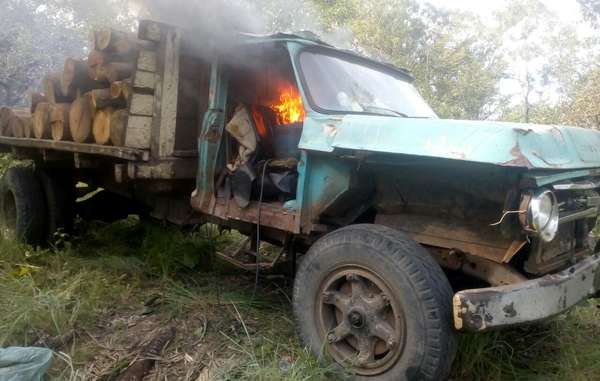
by Deep Green Resistance News Service | Aug 15, 2018 | Colonialism & Conquest
Featured image: The Guardians of the Amazon recently destroyed a logging truck they discovered in their territory. © Guardians of the Amazon
by Survival International
Warning: some people may find the details and image below disturbing
A leader of an Amazon tribe acclaimed for its environmental defenders has been killed, the latest in a series of deaths among the tribe.
The body of Jorginho Guajajara was found near a river in the Brazilian state of Maranhão. He was a leader of the Guajajara people, acclaimed internationally for their work as the ‘Guardians of the Amazon’ in the most threatened region in the entire Amazon.
It is not yet clear who killed him, but a powerful logging mafia has repeatedly targeted the tribe for its work protecting both its rainforest home, and the uncontacted members of a neighboring tribe, the Awá, who also live there, and face catastrophe unless their land is protected.
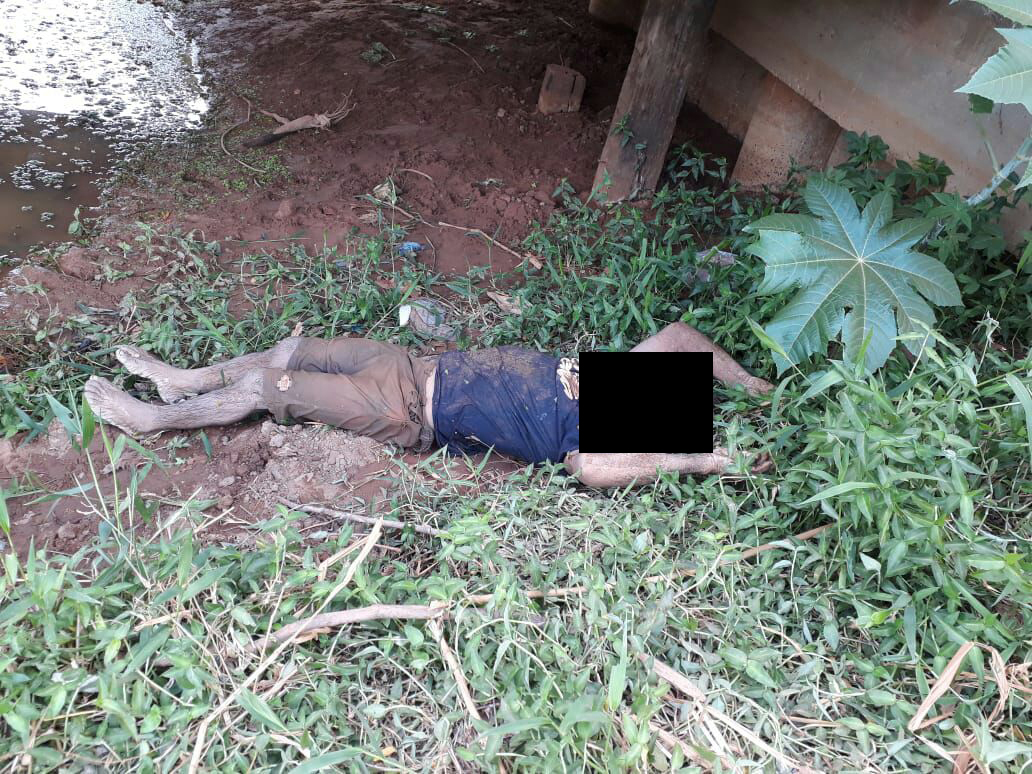
Jorginho Guajajara’s body was found near a river in the eastern Brazilian Amazon.
Confronted with official inaction, the tribe formed an environmental protection team named the Guardians of the Amazon to expel the loggers. Some estimates suggest up to 80 members of the tribe have been killed since 2000.
The murder of Jorginho Guajajara is further indication of the increasing volatility in this area. In May this year, a team from Ibama (Brazil’s environmental protection agency) and environmental military police were dispatched to the Guajajara’s Arariboia reserve, a rare move from the authorities.The Guajajara say: “Our uncontacted Awá relatives cannot survive if their forest is destroyed. As long as we live, we will fight for the uncontacted Indians, for all of us, and for nature.”
Survival International has protested to the Brazilian authorities about the wave of violence against the Guajajara, which has gone almost entirely unpunished.
Survival International Director Stephen Corry said today: “The Guardians of the Amazon face an urgent humanitarian crisis, and are fighting for their very survival. This small tribe of Amazon Indians are confronting an aggressive, powerful and armed logging mafia with close ties to local and national politicians. And they’re paying with their lives for standing up to them. They urgently need public support to make sure they survive.”
The Guardians of the Amazon
– The “Guardians of the Amazon” are men from the Guajajara tribe in Brazil’s Maranhão state who have taken it upon themselves to protect what remains of this eastern edge of the Amazon rainforest.
– They want to save the land for the hundreds of Guajajara families who call it home, and their far less numerous neighbors: the uncontacted Awá Indians.
– The Guardians say of their work: “We patrol, we find the loggers, we destroy their equipment and we send them away. We’ve stopped many loggers. It’s working.”
– The Guardians recently released video and images of a rare encounter with the uncontacted Awá living in Arariboia. Watch the footage here
– You can see videos of several of the Guardians talking about their work on Survival’s Tribal Voice site.
Arariboia
– The Arariboia indigenous territory comprises a unique biome in the transition area between the savannah and the Amazon rainforest.
– There are species here not found elsewhere in the Amazon.
– The land inside the indigenous territory is under threat from illegal loggers
– Brutal cuts in government funding to its indigenous affairs department FUNAI and tribal land protection mean the dangers are now even greater, as the area is not properly monitored or defended by the authorities.
– A powerful and violent logging mafia operates in the region, supported by some local politicians.

by Deep Green Resistance News Service | Jul 24, 2018 | Biodiversity & Habitat Destruction
by Max Wilbert / Deep Green Resistance
“Forests precede civilizations and deserts follow them.”
– François-René de Chateaubriand
New research in the prestigious journal Nature estimates that “the global number of trees has fallen by approximately 46% since the start of human civilization.”
The study also suggests that about 15 billion trees are being cut down each year, and that the average age of forests has declined significantly over the last few thousand years.
The study was led by researchers at the Yale School of Forestry and Environmental Studies with contributions from scientists at universities and research institutions in Utah, Chile, the UK, Finland, Italy, France, Switzerland, New Zealand, The Netherlands, Germany, Czech Republic, Brazil, and China.
While fossil fuels have only been burned on a large scale for 200 years, land clearance has been a defining characteristic of civilizations – cultures based around cities and agriculture – since they first emerged around 8,000 years ago.
This land clearance has impacts on global climate. When a forest ecosystem is converted to agriculture, more than two thirds of the carbon that was stored in that forest is lost, and additional carbon stored in soils rich in organic materials will continue to be lost to the atmosphere as erosion accelerates.
Modern science may give us an idea of the magnitude of the climate impact of this pre-industrial land clearance. Over the past several decades of climate research, there has been an increasing focus on the impact of land clearance on modern global warming. The Intergovernmental Panel on Climate Change, in its 2004 report, attributed 17% of global emissions to cutting forests and destroying grasslands – a number which does not include the loss of future carbon storage or emissions directly related to this land clearance, such as methane released from rice paddies or fossil fuels burned by heavy logging equipment.
Some studies show that 50% of the global warming in the United States can be attributed to land clearance – a number that reflects the inordinate impact that changes in land use can have on temperatures, primarily by reducing shade cover and evapotranspiration (the process whereby a good-sized tree puts out thousands of gallons of water into the atmosphere on a hot summer day – their equivalent to our sweating).
So if intensive land clearance has been going on for thousands of years, has it contributed to global warming? Is there a record of the impacts of civilization in the global climate itself?
10,000 years of Climate Change
According to author Lierre Keith, the answer is a resounding yes. Around 10,000 years ago, humans began to cultivate crops. This is the period referred to as the beginning of civilization, and, according to the Keith and other scholars such as David Montgomery, a soil scientist at the University of Washington, it marked the beginning of land clearance and soil erosion on a scale never before seen – and led to massive carbon emissions.
“In Lebanon (and then Greece, and then Italy) the story of civilization is laid bare as the rocky hills,” Keith writes. “Agriculture, hierarchy, deforestation, topsoil loss, militarism, and imperialism became an intensifying feedback loop that ended with the collapse of a bioregion [the Mediterranean basin] that will most likely not recover until after the next ice age.”
Montgomery writes, in his excellent book Dirt: The Erosion of Civilizations, that the agriculture that followed logging and land clearance led to those rocky hills noted by Keith.
“It is my contention that the invention of [agriculture] fundamentally altered the balance between soil production and soil erosion – dramatically increasing soil erosion.
Other researchers, like Jed Kaplan and his team from the Avre Group at the Ecole Polytechnique Fédérale de Lausanne in Switzerland, have affirmed that preindustrial land clearance has had a massive impact on the landscape.
“It is certain that the forests of many European countries were substantially cleared before the Industrial Revolution,” they write in a 2009 study.
Their data shows that forest cover declined from 35% to 0% in Ireland over the 2800 years before the beginning of the Industrial Revolution. The situation was similar in Norway, Finland, and Iceland, where 100% of the arable land was cleared before 1850.
Similarly, the world’s grasslands have been largely destroyed: plowed under for fields of wheat and corn, or buried under spreading pavement. The grain belt, which stretches across the Great Plains of the United States and Canada, and across much of Eastern Europe, southern Russia, and northern China, has decimated the endless fields of constantly shifting native grasses.
The same process is moving inexorably towards its conclusion in the south, in the pampas of Argentina and in the Sahel in Africa. Thousands of species, each uniquely adapted to the grasslands that they call home, are being driven to extinction.
“Agriculture in any form is inherently unsustainable,” writes permaculture expert Toby Hemenway. “We can pass laws to stop some of the harm agriculture does, but these rules will reduce harvests. As soon as food gets tight, the laws will be repealed. There are no structural constraints on agriculture’s ecologically damaging tendencies.”
As Hemenway notes, the massive global population is essentially dependent on agriculture for survival, which makes political change a difficult proposition at best. The seriousness of this problem is not to be underestimated. Seven billion people are dependent on a food system – agricultural civilization – that is killing the planet.
The primary proponent of the hypothesis – that human impacts on climate are as old as civilization – has been Dr. William Ruddiman, a retired professor at the University of Virginia. The theory is often called Ruddiman’s Hypothesis, or, alternately, the Early Anthropocene Hypothesis.
Ruddiman’s research, which relies heavily on atmospheric data from gases trapped in thick ice sheets in Antarctica and Greenland, shows that around 11,000 years ago carbon dioxide levels in the atmosphere began to decline as part of a natural cycle related to the end of the last Ice Age. This reflected a natural pattern that has been seen after previous ice ages.
This decline continued until around 8000 years ago, when the natural trend of declining carbon dioxide turned around, and greenhouse gases began to rise. This coincides with the spread of civilization across more territory in China, India, North Africa, the Middle East, and certain other regions.
Ruddiman’s data shows that deforestation over the next several thousand years released 350 Gigatonnes of carbon into the atmosphere, an amount nearly equal to what has been released since the Industrial Revolution. The figure is corroborated by the research of Kaplan and his team.
Around 5000 years ago, cultures in East and Southeast Asia began to cultivate rice in paddies – irrigated fields constantly submerged in water. Like an artificial wetland, rice paddies create an anaerobic environment, where bacteria metabolizing carbon-based substances (like dead plants) release methane instead of carbon dioxide and the byproduct of their consumption. Ruddiman points to a spike in atmospheric methane preserved in ice cores around 5000 years ago as further evidence of warming due to agriculture.
Destruction of the land as the root
The anti-apartheid organizer Seve Biko wrote in the 1960’s that “One needs to understand the basics before setting up a remedy. A number of organizations now currently ‘fighting against apartheid’ are working on an oversimplified premise. They have taken a brief look at what is, and have diagnosed the problem incorrectly. They have almost completely forgotten about the side effects and have not even considered the root cause. Hence whatever is improved as a remedy will hardly cure the condition.”
The same could be said of much of the modern environmental movement. While coal, oil, and gas are without a doubt worthwhile targets for opposition, the “climate” movement has forgotten the primary importance of the meadows, the grasslands, the forests, the mountains, and the rivers.
Without this, the movement has been led astray. It’s no wonder that ineffective solutions and tepid reforms that actually strengthen global empire are being promoted, instead of what is actually needed: revolutionary overthrow of this system of power.
Image: CC BY-NC-ND 2.0, Kate Evans/CIFOR, https://www.flickr.com/photos/cifor/35035343564

by Deep Green Resistance News Service | Jul 13, 2018 | Defensive Violence
Featured image by Souparno Chatterjee
by Chandan Sarma / Youth Ki Awaaz
Hakim Sinan village, Ranibandh Block, Bankura District, West Bengal:
It was getting dark in the forest. At a distance, light was gleaming from oil lamps in the village.
“Did you breastfeed these Saal trees? Why are you stopping us from cutting them down?” growled the poachers.
“How can you breastfeed your own mother?” retorted the resolute Adivasi women.
Culturally, forests have played a vital role in the lives of the Santhal tribes. This is much more evident in villages that live on the fringes of the forests. It is a relationship built on reverence and compassion.
Forests provide the tribes with fuelwood, leaves, herbs, fruits and honey. It is also the abode of many Gods and Goddesses. In fact, Santhals are proudly the forest people. The isolated Hakim Sinan village in Bankura district of West Bengal is an embodiment of this relationship of tribal communities with the forest. For Adivasi women, this bond is even stronger; the forest nurtures the community like a mother.

Illegal logging in this forest village had always been a problem. There had been intermittent and uncoordinated protests by many in the community. Women in the village had raised the issue on their own when they would cross the timber mafia in the forests. But not a leaf moved.
When NGO PRADAN started organising the Santhal women of Hakim Sinan village into Self-Help Groups (SHG) some years back, it was their first close interaction with outsiders. Interestingly, no one in this village had ever been to a bank: let alone open a bank account. A savings and credit group was formed which helped the families save money periodically and supported them for their credit needs. But this is not a story of financial sustainability – it is a story of the transformation of women from this village into an unwavering collective who can stand for their rights and values they cherish. Even in the face of life-threatening danger.
As poor and vulnerable Adivasi women in this village were organised, they grew in strength and confidence. Unfortunately, during this period, unabated illegal logging exacerbated to the point that it threatened the very existence of their forest. The destruction of their culture and harmonious relationship with Mother Nature stared at them. Moved by this destruction, this unified group of women decided to take a stand. But they were up against men with arms and influence. All they had were mere sickles and sticks and an insurmountable belief in their own collective strength.

When the women in one of their group meetings announced that they would now take turns to guard the forest every night, the rest of the village was bewildered. ‘How will these frail women take on the poachers?’
So, it began: the women grouped themselves and every night, one group would vigil the forests. Simultaneously, they lodged a complaint at the forest department.
The Nights Of Skirmish
On a moonlit night, one group of ‘guarding women’ came face to face with the poachers. One woman ran back to the village. An altercation ensued. A knife was put to the throat of Lokkhimuni Soren. The mighty were ready to shed blood. In the meantime, the rest of the women dashed to the forest. This group of 15 women was not backing down. The poachers threatened to come back with greater force.

On another night of skirmish, the poachers growled, “Did you breastfeed these saal trees? Why are you stopping us from cutting them down? Who are you to stop us?”
“How can you breastfeed your own mother? This forest is our mother and we will give our lives but will not let you cut the trees,” they retorted.
The poachers had to go back empty-handed again. More skirmishes followed but they halted the devastation of their forest.

The news of Adivasi women standing up to powerful poachers spread like forest fire. The women also repeatedly engaged with the Forest Ranger. An official meeting was arranged between them and forest officers. All poachers were subsequently arrested. Each one of them was fined ₹5,000. Illegal logging of trees in the vicinity of Hakim Sinan village and beyond has abated. There is still an undercurrent of threat to this collective from vested interests but the women of this SHG are confident of taking on any challenge to save their forest: their Goddess, their Mother.

Photo Credit: Souparno Chatterjee, PRADAN
Additional Inputs to the Story: Souparno Chatterjee; PRADAN Khatra Team, Bankura district, West Bengal.
Originally published on Youth Ki Awaaz. Republished with permission.
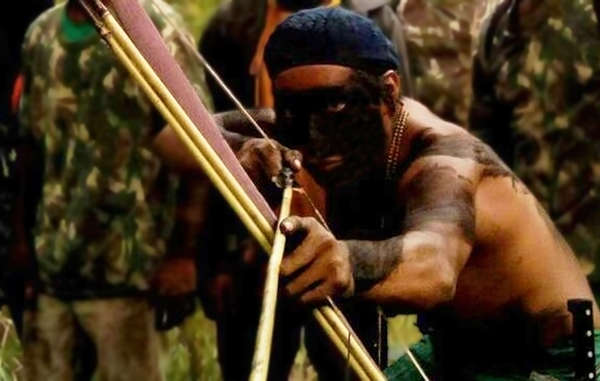
by Deep Green Resistance News Service | May 22, 2018 | Defensive Violence
Featured image: Guardians of the Amazon from the Guajajara tribe: “We patrol, we find the loggers, we destroy their equipment and we send them away. We’ve stopped many loggers. It’s working.” © Guardians of the Amazon
by Survival International
Members of an Amazon tribe patrolling their rainforest reserve to protect uncontacted relatives from illegal loggers have seized a notorious logging gang, burned their truck, and expelled them from the jungle.
The Guardians of the Amazon are from the Guajajara tribe: “We patrol, we find the loggers, we destroy their equipment and we send them away. We’ve stopped many loggers. It’s working.”
The area they are defending, Arariboia, is in the most threatened region in the entire Amazon. It is home to an uncontacted group of Awá Indians, a tribe well known for their affinity with animals and understanding of the forest, who face total annihilation if they come into contact with the loggers.
The Guardians have recently found abandoned Awá shelters close to where the loggers operate.
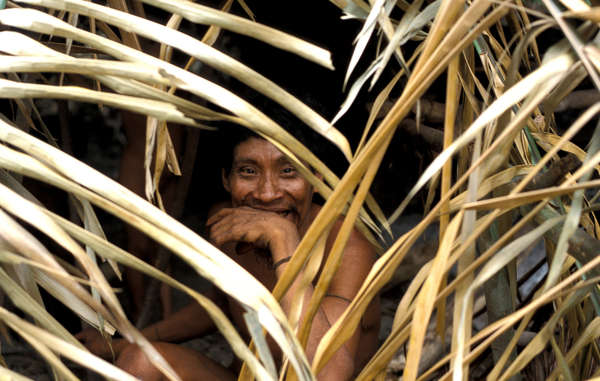
An Awá man called Takwarentxia, who was contacted in 1992 with his wife Hakõa’ĩ, and their baby. The rest of his family were killed by gunmen working for ranchers clearing the land. © Fiona Watson/Survival
They now fear violent retaliation. Three of the Guardians were murdered by loggers in 2016, and they have experienced arson attacks and regular death threats.
Burning Truck from Survival International on Vimeo.
The Guardians sent footage of the burning truck loaded with illegally cut timber to Survival International, along with the message: “Please show the world the reality we face. We know it’s risky and we have enemies but now’s no time for hiding. We want you to release this to the world so we can continue to protect our forest.”
Survival International has written urgently to the Brazilian government calling for the immediate and long term protection of both the Guardians themselves and of the area they fight to protect. Survival are also asking members of the public to send emails in support of the Guardians to government ministers via this page on their website.
Survival’s Director Stephen Corry said: “Tribal territories are the best barrier to deforestation, and these Guardians are defending the last patch of green amid a sea of destruction. It’s further proof that tribal peoples are the best conservationists and guardians of the natural world. The Guardians are virtually the only people standing between the loggers and the uncontacted Awá who still hold out in this forest. The Brazilian government’s inaction in the face of rampant illegal deforestation is shameful.”
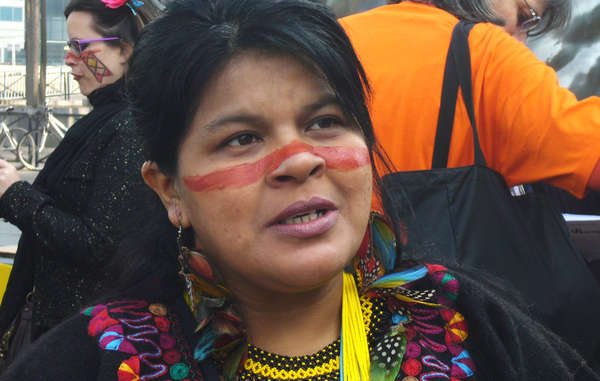
Sônia Guajajara at a protest in Paris against Brazil’s plans for a series of mega-dams in the Amazon, March 2014. © Survival International
She said today: “The Guardians’ work is both extremely valuable and incredibly risky. We indigenous peoples will never accept the ransacking of our Mother Earth – we listen to her and understand the way she talks to us because our life depends on her.”
BACKGROUND BRIEFING
The Guardians of the Amazon
– The “Guardians of the Amazon” are men from the Guajajara tribe in Brazil’s Maranhão state who have taken it upon themselves to protect what remains of this eastern edge of the Amazon rainforest.
– They want to save the land for the hundreds of Guajajara families who call it home, and their far less numerous neighbors: the uncontacted Awá Indians.
– The Guardians say of their work: “We patrol, we find the loggers, we destroy their equipment and we send them away. We’ve stopped many loggers. It’s working.”
– The Guardians recently released video and images of a rare encounter with the uncontacted Awá living in Arariboia. Watch the footage here
– You can see videos of several of the Guardians talking about their work on Survival’s Tribal Voice site.
Uncontacted tribes
– There are more than 100 uncontacted tribes worldwide. They have decided not to engage in regular contact with anyone from the outside world.
– They are not “lost” or trapped in a land that time forgot. They are aware of the outside world, and may engage sporadically with contacted tribes nearby.
– There’s irrefutable evidence that their tribal territories are the best barrier to deforestation, particularly in the Amazon rainforest.
– Uncontacted tribes are the most vulnerable peoples on the planet. Whole populations are wiped out by violence from outsiders who steal their land and resources, and by diseases like the flu and measles to which they have no resistance.
– It is not uncommon for 90% of the population to be wiped out following initial contact.
Awá
– The Awá are a hunter-gatherer people living in the forests of the eastern Brazilian Amazon
– While some Awá are in contact with the outside world, others are uncontacted.
– The Awá were known as “the most threatened tribe in the world” during a successful campaign by Survival International for the Brazilian government to expel the illegal loggers from one of their territories.
– The tribe are known for their affinity with the animals of their forest, and some families have more pets than people, from raccoon-like coatis to wild pigs and king vultures.
– Monkeys are the Awá’s favorites and individuals are often seen with their pet monkey riding on their head. Awá will rescue orphaned baby monkeys and adopt them as a member of the family, even breastfeeding them.
Arariboia
– The Arariboia indigenous territory comprises a unique biome in the transition area between the savannah and the Amazon rainforest.
– There are species here not found elsewhere in the Amazon.
– The land inside the indigenous territory is under threat from illegal loggers
– Brutal cuts in government funding to its indigenous affairs department FUNAI and tribal land protection mean the dangers are now even greater, as the area is not properly monitored or defended by the authorities.
– A powerful and violent logging mafia operates in the region, supported by some local politicians.
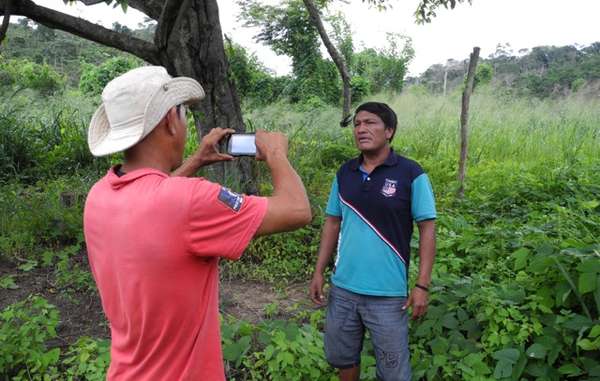
by Deep Green Resistance News Service | May 11, 2018 | Indigenous Autonomy
Featured image: With support from Survival, the Guajajara are able to expose illegal logging and threats to their uncontacted neighbors in real time. © Survival
by Sarah Shenker / Survival International
“We are here,” says Olimpio, looking directly into the camera, “… Monitoring the land and protecting the uncontacted Indians and the Guajajara who live here. Why? Because there are some people – anthropologists from some countries – who want, once again, to violate the rights of the uncontacted Indians in the country.”
Olimpio remains calm, but you can sense tension as he continues to speak.
“We are aware that some anthropologists have been calling for ‘controlled contact’ with the uncontacted Indians… We will not allow this to happen, because it would be another genocide.”
Olimpio is among the leaders of a group known as the “Guajajara Guardians,” men from the Guajajara tribe in Brazil’s Maranhão state who have taken it upon themselves to protect what remains of this north-eastern edge of the Amazon rainforest, the hundreds of Guajajara families who call it home, and their far less numerous neighbors: the Awá Indians, some of whom are uncontacted.
Uncontacted tribes are the most vulnerable peoples on the planet, and the Guajajara are acutely aware of this. Whole populations are being wiped out by violence from outsiders who steal their land and resources, and by diseases like flu and measles to which they have no resistance. The Guajajara know that the destruction of the forest, which the Awá have been dependent on and managed for generations, spells doom for the Awá and the Guajajara alike. All uncontacted peoples face catastrophe unless their land is protected. Without it, the Awá simply won’t survive.
The satellite imagery is startling: this territory, known as Arariboia, is an island of green amidst a sea of deforestation in this corner of the Amazon, which has been plundered for its iron ore; opened up by roads and rail; and chopped down for its valuable hardwoods.
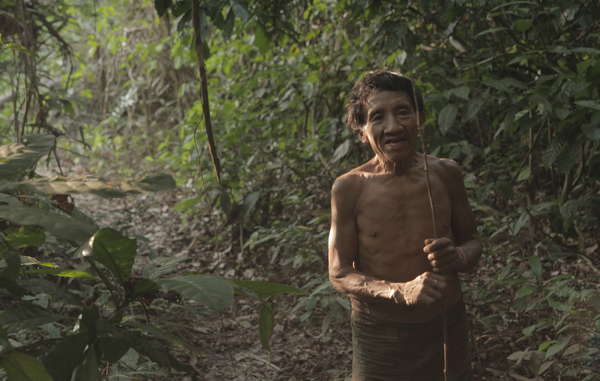
The Awá are one of the most vulnerable peoples on the planet. Some of them have no contact with mainstream Brazilian society, though the majority do. © Survival International
The uncontacted nomadic Awá live on a small hill in the centre of this island, where they hunt, fish, and collect fruits and berries. Its forest cover is thicker than that below. Following centuries of invasion, the Awá’s hill has become their refuge. They now number no more than several dozen.
As we looked up towards the uncontacted Arariboia Awá’s forest, it struck me that they really are living on the edge. Following centuries of land invasion and theft, and genocidal violence, they are clinging on against all odds. Preventing their annihilation is a matter of now or never.
I was here to learn about the Guajajara Guardians’ work and to set them up with communications technology as part of Survival International’s Tribal Voice project, which allows remote tribal peoples to send video messages around the globe in real time. It is one of the ways in which we work in partnership with them, and give them a platform to speak to the world. They were very enthusiastic about the possibilities this might offer, allowing them to expose logging and other attacks on Arariboia, and share information from their expeditions to protect their Awá neighbors.
First of all, however, Olimpio decided to record a denunciation of two American academics, Kim Hill and Robert Walker, rejecting outright their calls for forced contact with uncontacted tribes.
“It would be another genocide of a people, of indigenous people, who do not want contact, either with us, or with non-indigenous people” he says. It is hard not to be impressed by his determination.
*
Much of this region of Maranhão doesn’t really feel like the Amazon. The state borders the northeastern coast of Brazil and stretches downwards into the Amazon basin, but you don’t see the thick forests that people generally imagine when they picture the world’s largest rainforest. Instead, much of the area has been given over to agriculture in the form of ranches and plantations, or abandoned after the loggers have had their way with it and moved on.
After driving through countless miles of bleached brown grass, it is refreshing to reach Arariboia. The indigenous territory is home to the Guajajara and Awá peoples. Arariboia and other indigenous territories in the region are virtually the only remaining areas of genuine forest in the state. Crossing the border into indigenous land, things don’t feel all too different at first – in fact, vast swathes of forest in the territory were destroyed by fires last year, believed to have been started by the region’s powerful logging mafia. But the further into the area you head, the more you get the sense that you are in an island of lush greenery in the middle of the destruction so common elsewhere in this part of Brazil.
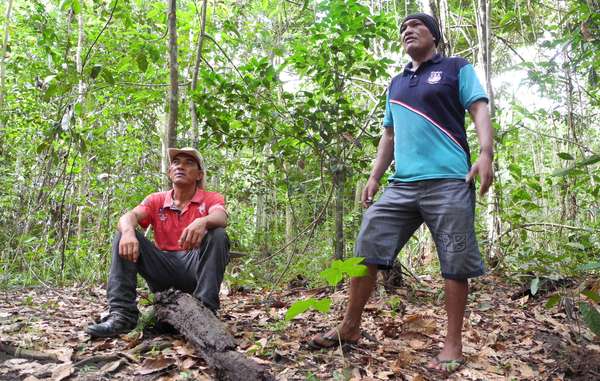
Olimpio and Franciel, coordinators of the Guajajara Guardians, are determined to protect the forest for their uncontacted Awá neighbors. © Survival
Although it is strictly forbidden under Brazilian law for outsiders to fell trees in indigenous territories, here and elsewhere in the Amazon loggers constantly flaunt this with impunity. Just on the drive up to Arariboia we passed dozens of loggers, their trucks piled high with illegally felled logs. I took a photo of one truck driven by two young men looking particularly pleased with their collection, and realized very quickly that they didn’t care. They do not attempt to hide their faces or their operations as they knew that the local government – largely controlled by the mafias who run this trade – will carry on turning a blind eye.
However, it is harder than ever for bandit loggers to operate in Arariboia. The Guardians, of whom there are around fifty, patrol the forest, monitoring, keeping their eyes open, and notifying the authorities. They do it in shifts, in their own time, with only sporadic financial and logistical support from the Brazilian government, despite its formal commitment to protecting the rainforest and indigenous rights. The work is time-consuming and far too much for a small band of committed volunteers. And it’s dangerous: In recent years, several Guajajara have been assassinated.
Why then, do they do it? I found it difficult to fathom at first. It is common for loggers to intimidate and murder indigenous people, so many feel forced into silent acceptance of the loggers and their activities. Sadly in this part of Brazil, many Guajajara also collaborate with the loggers, hoping to make some money from the trade, which they see as unstoppable. Alienated, threatened, and living on the fringes of a society that barely accepts them, the Guardians’ motivation for self-imposed vigilante duty is not outwardly obvious.
*
The more time I spent with the Guajajara in Arariboia, however, the more it seemed to make sense. Members of the tribe who live in the center of their land, closest to the Awá’s hill, are less integrated into mainstream Brazilian society, and feel a stronger sense of connection to their communal ways. They thrive in the forest, knowing it intimately and practising Guajajara rituals.
While I was there I witnessed one of these – a coming of age ceremony for a Guajajara girl. The tribe considers a girl’s first menstruation to be a hugely significant time, marking the passage into adulthood, and celebrate it as a community. The girl spent a week living in a small hut with a palm frond roof, attended by female relatives who would bring her food. Rather than being a solemn isolation, however, the rite of passage is a great celebration, and the Guajajara frequently burst into song and dance, paint their faces and revel in the girl’s new maturity. The men of the village, though not allowed to enter the hut, often come and stand close to the entrance and join in the singing.
Experiencing this put the Guardians’ desire to protect their forest and fellow indigenous people into context. To them, Arariboia is not a resource to be exploited in the name of “progress” and “civilization” – it is fundamental to who they are. They take great pride in it, protect what is left of it, and feel a deep sense of connection to it.
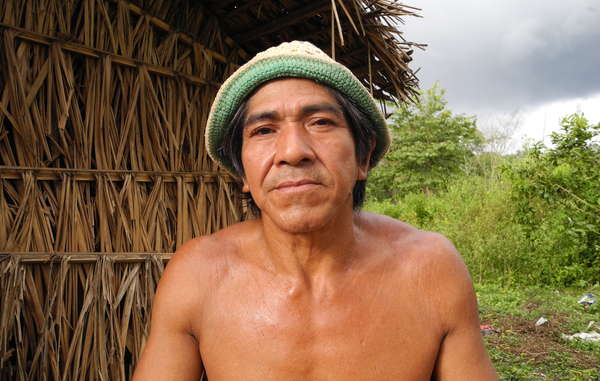
Survival has been working with the Guardians since 2015. © Survival
“People can’t take their land away from them,” another of the Guardians said to me, outraged, as we trekked through the forest close to one of the logging hotspots, “and they can’t take them away from their land.” He was indicating the Awá’s hill, which towers over the surrounding scrubland and lighter forest and provides a focal point in the landscape. The uncontacted Awá living there have expressed their desire to remain uncontacted, and the Guajajara want to see that desire respected.
Some see the centuries-long battle for survival between the indigenous peoples of the Amazon and the colonizers who exploit and destroy it as hopeless. Some, including the American anthropologists who the Guajajara were so keen to refute, see contact as inevitable and isolated uncontacted peoples as doomed. Deforestation will continue, they claim, and so tribal people will either have to assimilate with the Brazilian mainstream, or else face annihilation.
The Guajajara Guardians see it differently. They know what contact, “development,” and “progress” can mean for tribal peoples. They have watched as more and more of the forest that their ancestors were dependent on and managed for generations has been destroyed. And they’re keen to fight back, by boosting their land protection expeditions which are succeeding in keeping loggers out of some key areas, and by sharing their concerns with the world and encouraging international support.
For any tribal people, land is the key to survival. We’re doing everything we can to secure it for them, and to give them the chance to determine their own futures.
That’s also why Survival is giving the Guajajara, and other tribes, communications technology so they can speak to the world in real time. Their understanding of the problems they and their neighbors face is as astute as anyone’s and they have perceptive things to say about almost every aspect of life today. They are not only the best conservationists and guardians of the natural world, but are also at the forefront of the fight for human rights and self-determination. Maybe it’s time to listen.
Sarah Shenker was in conversation with Survival’s Lewis Evans
Act now to support the Guajajara Guardians
















